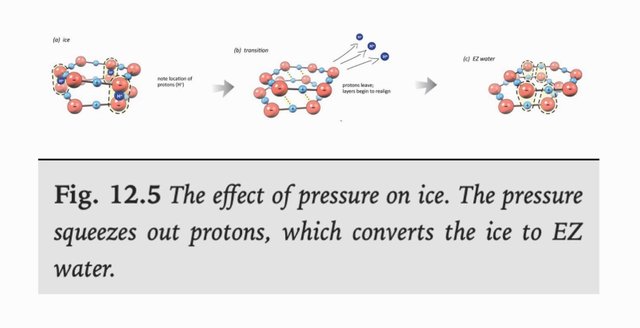Are fish using hydrostatic pressure to produce O2 in the swim bladder by osmosis?
It is known that the percentage of O2 in swim bladders of fish increase with increased pressure (Hall, 1924). This was first discovered because fish caught at lower depths had higher percentage of O2 in relation to N2 in their swim bladder (Hall, 1924), and then reproduced experimentally with fish in pressure chambers (Hall, 1924). It is also known that the gas gland of the swim bladder produces lactate (D’Aoust, 1970).
Pyruvate as cathode in osmosis and production of O2
Lactate is produced from pyruvate burning in hydrogen gas. An increase in the ambient pressure will compress the swim bladder and increase the pressure acting on the water on the epithelia of the gas gland, increasing the quantity of water in the “surface phase”, (H3O2-)n.
The image below from Gerald Pollack's book The Fourth Phase of Water illustrates how the "surface phase" of water is compressed ice.

This increase in osmotic pressure (osmotic pressure directly proportional to the interfacial water since it is produced by it, see Zhao, 2009) will transfer protons across the gas gland epithelia, liberate O2 in the swim bladder, and generate an electric current across the gas gland epithelia. The electrons from this current will combine with the protons, and with pyruvate, to produce lactate.
The swim bladder exploiting the energy in hydrostatic pressure with increased depth?
Thilo (1906) has persistently contended that the blood of fish is not sufficient in quantity to supply the amount of gas found in the bladder. Maybe he was right.
Glucose consumption in gas gland
Massive amounts of glucose are consumed by gas gland, see Clow, 2016 and quote below. Fits. The thing is, producing O2 with glucose is expensive. We humans use on average 22 mole O2 per day but only like 0.8 mole glucose.
"Glucose metabolism by isolated gas gland cells was 12- and 170- fold higher, respectively, than that in heart and red blood cells (RBCs) as determined by the production of 3 H2O from [2-3 H] glucose. In the gas gland, essentially all of the glucose consumed was converted to lactate. "
Synapses
HALL, F. G. (1924). THE FUNCTIONS OF THE SWIMBLADDER OF FISHES. The Biological Bulletin, 47(2),79-[126]-1. https://doi.org/10.2307/1536532
D’Aoust, B. G. (1970). The role of lactic acid in gas secretion in the teleost swimbladder. Comparative Biochemistry and Physiology, 32(4), 637–644. https://doi.org/10.1016/0010-406x(70)90818-2
Pollack, G., 2013. The Fourth Phase Of Water. Seattle: Ebner and Sons.
Zhao, Q., Ovchinnikova, K., Chai, B., Yoo, H., Magula, J., & Pollack, G. H. (2009). Role of Proton Gradients in the Mechanism of Osmosis. The Journal of Physical Chemistry B, 113(31), 10708–10714. https://doi.org/10.1021/jp9021568
Thilo, O. (1906). Die Luftwege der Schwimmblase. Zool. Anz. 30, 591–604
Clow, K. A., Short, C. E., Hall, J. R., Gendron, R. L., Paradis, H., Ralhan, A., & Driedzic, W. R. (2016). High rates of glucose utilization in the gas gland of Atlantic cod (Gadus morhua) are supported by GLUT1 and HK1b. The Journal of Experimental Biology, 219(17), 2763–2773. https://doi.org/10.1242/jeb.141721
SUBSCRIBE
#StockPhotos
https://steemit.com/trending/hive-109286
The best place to share your free to use stock photos and earn STEEM & TRX.
Your post is rewarded and we support every member of the community!
You've got a free upvote from witness fuli.
Peace & Love!